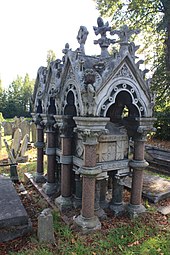
Back Kensal Green-begraafplaas Afrikaans Kensal Green Cemetery German Cementerio de Kensal Green Spanish Kensal Greengo hilerria Basque گورستان کنسال گرین Persian Cimetière de Kensal Green French Kensal Green Cemetery Italian Kensal Green Cemetery Dutch Cmentarz Kensal Green Polish Cemitério de Kensal Green Portuguese
| Kensal Green Cemetery | |
|---|---|
 | |
 | |
| Details | |
| Established | 1832 |
| Location | |
| Country | England |
| Coordinates | 51°31′43″N 0°13′27″W / 51.5286°N 0.2241°W |
| Type | Private |
| Style | Neoclassical |
| Owned by | The General Cemetery Company |
| Size | 29 hectares (72 acres) |
| No. of graves | 65,000+ |
| No. of interments | 250,000 |
| Website | The General Cemetery Company website |
| Find a Grave | Kensal Green Cemetery |
Listed Building – Grade I | |
| Official name | Kensal Green Cemetery |
| Designated | 1 October 1987 |
| Reference no. | 1000817 |
| Official name | Kensal Green Cemetery |
| Designated | 1 October 1987 |
| Reference no. | 1000817 |




Kensal Green Cemetery is a cemetery in the Kensal Green area of North Kensington in the Royal Borough of Kensington and Chelsea and the London Borough of Hammersmith and Fulham in London, England. Inspired by Père Lachaise Cemetery in Paris, it was founded by the barrister George Frederick Carden.[1] The cemetery opened in 1833 and comprises 72 acres (29 ha) of grounds, including two conservation areas, adjoining a canal. The cemetery is home to at least 33 species of bird and other wildlife. This distinctive cemetery has memorials ranging from large mausoleums housing the rich and famous to many distinctive smaller graves and includes special areas dedicated to the very young. It has three chapels and serves all faiths.[2] It is one of the Magnificent Seven cemeteries in London.
The cemetery was immortalised in the lines of G. K. Chesterton's poem "The Rolling English Road" from his book The Flying Inn:[3]
For there is good news yet to hear and fine things to be seen;
Before we go to Paradise by way of Kensal Green.
Despite its Grecian-style buildings, the cemetery is primarily Gothic in character, due to the high number of private Gothic monuments. Due to this atmosphere, the cemetery was the chosen location of several scenes in movies, notably in Theatre of Blood.[citation needed]
The cemetery is listed Grade I on the Register of Historic Parks and Gardens.[4] It remains in use.
- ^ The Founding of Kensal Green Cemetery Archived 13 June 2012 at the Wayback Machine, Kensalgreen.co.uk, accessed 7 February 2014
- ^ "Kensal Green Cemetery – and West London Crematorium". kensalgreencemetery.com.
- ^ Chesterton, Gilbert Keith (1914). "The Rolling English Road". The Flying Inn.
- ^ Historic England. "Kensal Green (All Souls) Cemetery (1000817)". National Heritage List for England. Retrieved 13 November 2017.